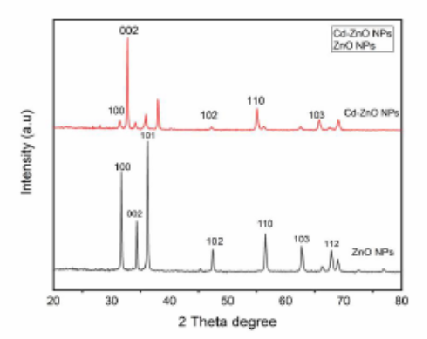


Indian Journal of Science and Technology
Year: 2023, Volume: 16, Issue: 25, Pages: 1918-1926
Original Article
Munusamy Kalaivani1*, Subramaniyan Ravi2
1Research scholar, Department of Physics, Faculty of Science, Annamalai University, Chidambaram, Tamil Nadu, India
2Associate Professor, Department of Engineering Physics, Faculty of Science, Annamalai University, Chidambaram, Tamil Nadu, India
*Corresponding Author
Email: [email protected]
Received Date:24 January 2023, Accepted Date:08 April 2023, Published Date:27 June 2023
Objectives: To evaluate structural and morphological character of Zinc oxide and Cadmium doped zinc oxide nanoparticles and its nano-fertilizer property also measured. Methods: ZnO and CdO-ZnO nanoparticles synthesized by water hyacinth (Eichhornia crassipes), Aqueous extract of water hyacinth (E. crassipes) acts as a reducing and capping agent for the synthesis of ZnO and CdO-ZnO nanoparticles. The product was characterized by X-ray diffraction (XRD), Fourier transform infrared spectroscopy, Scanning electron microscopy (SEM) with energy dispersive X-ray analysis (EDX) and UV-Visible spectroscopy to ascertain its formation. With application of Nano fertilizer to low marginal soils for cultivation of cassava, the macronutrients and micronutrients enhanced by Nano fertilizer microbial inoculant that transforms roots development, photosynthetic rate, replenished extracted soil nutrients by cassava harvest and improved nitrogen use efficiency. Findings: The Greener method is very useful environmentally to reduce the hazardous solvent and some other chemical reagents. This study has proved the uilization of water hyacinth (E. crassipes) extract, as a good reducing agent, for the above nanoparticles synthesis. With the application of Nano fertilizer to low marginal soils for cultivation of cassava, the macronutrients and micronutrients are enhanced by nano fertilizer microbial inoculants that transforms roots development, photosynthetic rate, replenished extracted soil nutrients by cassava harvest and improved nitrogen use efficiency. Novelty: The present work authenticated that Nano fertilizer applied cassava production soil provides interactions which produces stability and resilience of soil with respect to functional characteristics. However, the effect of each green manure on cassava plant height, number of branches and yield depends on its chemicalcomposition. ZnO nanoparticles dispersed in Nano fertilizer to cassava plant 0-10 month in experimental trail plant shows significant increase in height branches of leaves and tuber yield for and treatment- 1(ZnO NPs ) and cassava treatment-2 (ZnO and CdO-ZnO) , treatment 3 (Chemical fertilizer ) and treatment -4 control by 23.91%, 28.91% ,18.67% and 14.58 % respectively, when compared to the control. Applications of Nano fertilizer ZnO NPs and CdO-ZnO dispersed in applied to the cassava plant can significantly enhance its growth and yield performance. These findings make it useful to produce new Nano fertilizer in various metal and metal dopped nanoparticles.
Keywords: Green synthesis; Water hyacinth plant; Nano fertilizer
© 2023 Kalaivani & Ravi. This is an open-access article distributed under the terms of the Creative Commons Attribution License, which permits unrestricted use, distribution, and reproduction in any medium, provided the original author and source are credited. Published By Indian Society for Education and Environment (iSee)
Subscribe now for latest articles and news.